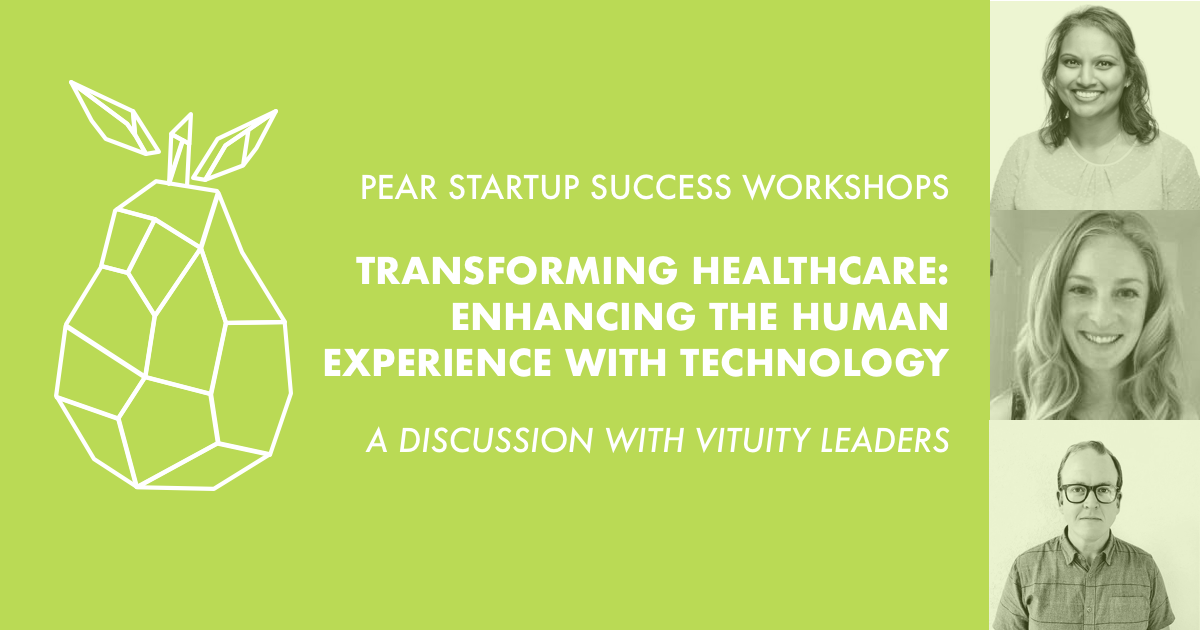
This is a recap of our discussion with Lindsay Kriger, Director of Transformation and Business Operations, Andrew Smith, Chief Operations and Innovation Officer, and Dr. Bobbie Kumar, a family physician, from Vituity, the largest physician-owner partnership in the U.S.
Watch the full talk at pear.vc/speakers and RSVP for the next!
Healthcare innovation is local To get started, pick an area to focus on Recommendations for new healthcare solutions
Healthcare innovation is local
Though tackling the American healthcare system seems extremely daunting, the most important rule as a healthcare founder is to remember to keep the patients’ and the communities’ needs centered. Like any startup founder, healthcare providers need to know their users.
“The reality of healthcare innovation is that it’s local,” said Kriger, Vituity’s Director of Transformation and Business Operations. “We need to talk to real people from diverse backgrounds, geographies, cultures, and clinical care settings and build companies from passion and personal experience. That will ultimately create the healthcare that we all want.”
Often, this means bringing care directly to the patient, especially in the COVID era, when patients may be wary of coming to hospitals.
“There are many sick people in this country that aren’t coming to the hospital or asking anyone for help, so taking care of people at home, or in their grandparents’ house, or at an SNF, or anywhere they are and reaching out to them has become incredibly important,” explains Smith.
To get started, pick an area to focus on
Our healthcare system is a $6 trillion problem. We spend close to 18% of the GDP on healthcare every year and over $10,000 per capita—twice of what any other industrialized country spends.
Naturally, numerous technical solutions and innovations have emerged in this space. Because of how vast the market is, however, it can be difficult to figure out how to start.
This is where balance comes in. After thoroughly understanding your users, pick one area to focus on.
“If you try to solve all of the problems of healthcare in one swoop, it is going to be extremely difficult,” Smith emphasizes.
Smith underscores the importance of iteration and building feedback cycles from diverse sets of users.
“With whatever you’re rolling out, you need to hear from patients and providers–and not just in one location. One location is a great place to start, but one of my recommendations is having a diverse set of pilots.”
Again, because of how local healthcare is, understanding the specific needs of markets you are targeting will help you build the best solutions.
At scale, however, Vituity firmly believes that all users and all markets should be serviced.
“We’re going to take care of everyone equally, always. And we want to build solutions and products that work for the entire community in this country.”
Recommendations for new healthcare solutions
Dr. Bobbie Kumar, Director of Clinical Innovation at Vituity, thinks a key area for innovation in the healthcare space is physician productivity.
When Dr. Kumar was an intern, she had 45 minutes to meet each patient. As a doctor, she only gets 10-15 minutes to do the same amount of work.
“Reducing the administrative burden that myself and the care team have to experience is going to be a very key and poignant feature in how solutions are able to penetrate the healthcare space,” she added.
Beyond that, she leaves two other recommendations for innovating solutions within the healthcare industry.
“Disrupt the industry, not the mission,” she said. “The top two reasons for choosing medicine are help people, followed by intellectual pursuit— wanting to find something that’s challenging enough for the knowledge base and the research.”
The last recommendation? “Preserve the humanism.” Technological solutions simply cannot account for the degree of human interaction inherent in physician-patient relationships.
“Until we really start looking at healthcare as both patient-centric and provider and care team supported, we’re just going to end up missing the target. So, my hope for the future is that we disrupt the status quo and we model these solutions that not just promote, but really emphasize the value and the unique human experience.”